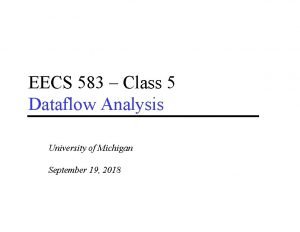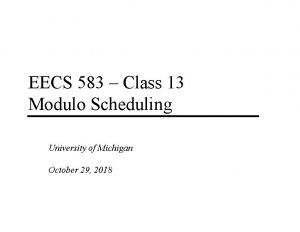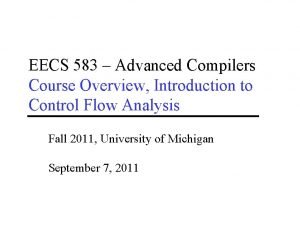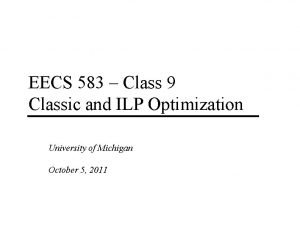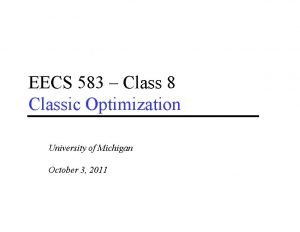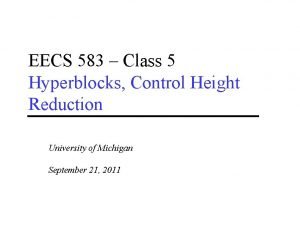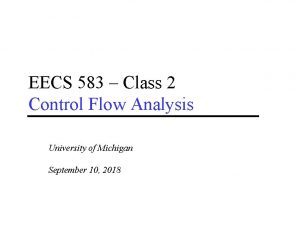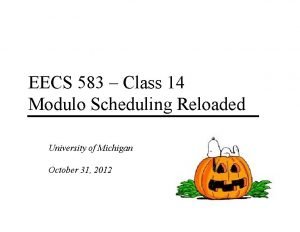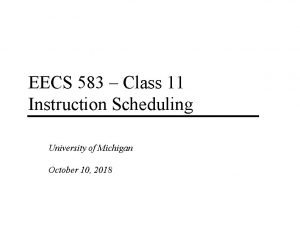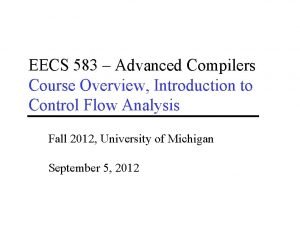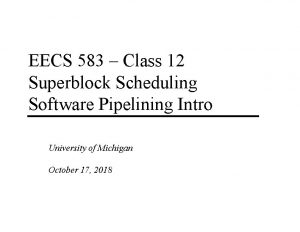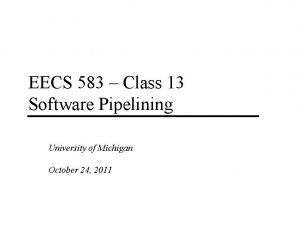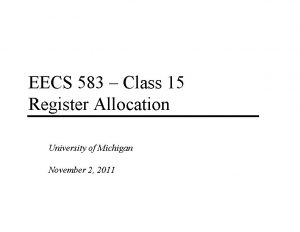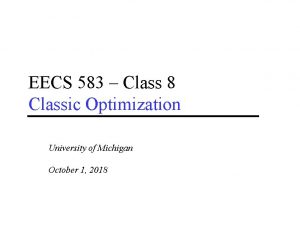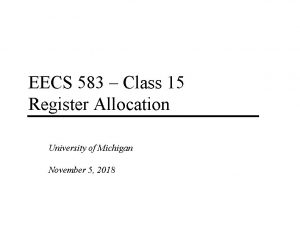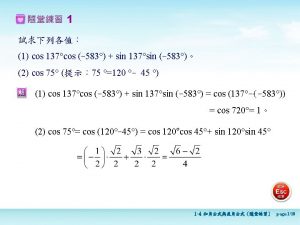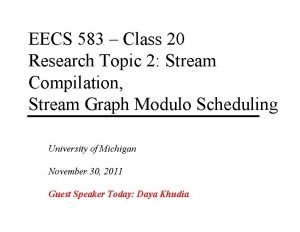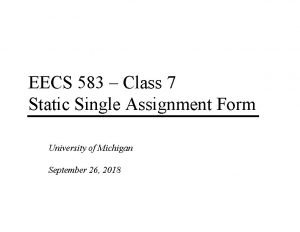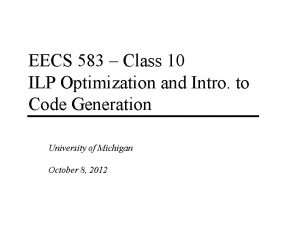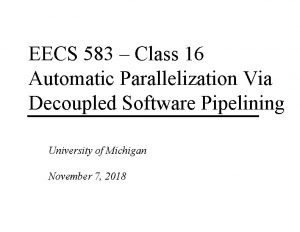EECS 583 Class 14 Modulo Scheduling Reloaded University

































- Slides: 33

EECS 583 – Class 14 Modulo Scheduling Reloaded University of Michigan October 31, 2012

Announcements + Reading Material v Project proposals » Due Friday, Nov 2, 5 pm » 1 paragraph summary of what you plan to work on Ÿ Topic, approach, objective (performance, energy, code size) » 1 -2 references » Email to me&James, cc your group members v Today’s class reading » "Code Generation Schema for Modulo Scheduled Loops", B. Rau, M. Schlansker, and P. Tirumalai, MICRO-25, Dec. 1992. v Next reading – Last class before research stuff! » “Register Allocation and Spilling Via Graph Coloring, ” G. Chaitin, Proc. 1982 SIGPLAN Symposium on Compiler Construction, 1982. -1 -

Review: Minimum Initiation Interval (MII) v v Remember, II = number of cycles between the start of successive iterations Modulo scheduling requires a candidate II be selected before scheduling is attempted » Try candidate II, see if it works » If not, increase by 1, try again repeating until successful v MII is a lower bound on the II » MII = Max(Res. MII, Rec. MII) » Res. MII = resource constrained MII Ÿ Resource usage requirements of 1 iteration » Rec. MII = recurrence constrained MII Ÿ Latency of the circuits in the dependence graph -2 -

Class Problem Latencies: ld = 2, st = 1, add = 1, cmpp = 1, br = 1 Resources: 1 ALU, 1 MEM, 1 BR 1: r 1[-1] = load(r 2[0]) 2: r 3[-1] = r 1[1] – r 1[2] 3: store (r 3[-1], r 2[0]) 4: r 2[-1] = r 2[0] + 4 5: p 1[-1] = cmpp (r 2[-1] < 100) remap r 1, r 2, r 3 6: brct p 1[-1] Loop Calculate Rec. MII, Res. MII, and MII -3 -

Review: Priority Function Height-based priority worked well for acyclic scheduling, makes sense that it will work for loops as well Acyclic: 0, if X has no successors Height(X) = MAX ((Height(Y) + Delay(X, Y)), otherwise for all Y = succ(X) Cyclic: 0, if X has no successors Height. R(X) = MAX ((Height. R(Y) + Eff. Delay(X, Y)), otherwise for all Y = succ(X) Eff. Delay(X, Y) = Delay(X, Y) – II*Distance(X, Y) -4 -

Calculating Height 1. 2. 3. 4. 5. 6. Insert control edges from all nodes to branch with latency = 0, distance = 0 (dotted edges) Compute II, For this example assume II = 2 Height. R(4) = 0 Height. R(3) = 0 H(4) + Eff. Delay(3, 4) = 0 + 0 – 0*II = 0 H(2) + Eff. Delay(3, 2) = 2 + 2 – 2*II = 0 MAX(0, 0) = 0 Height. R(2) = 2 H(3) + Eff. Delay(2, 3) = 0 + 2 – 0 * II = 2 H(4) + Eff. Delay(2, 4) = 0 + 0 – 0 * II = 0 MAX(2, 0) = 2 Height. R(1) = 5 H(2) + Eff. Delay(1, 2) = 2 + 3 – 0 * II = 5 H(4) + Eff. Delay(1, 4) = 0 + 0 – 0 * II = 0 MAX(5, 0) = 5 -5 - 1 0, 0 3, 0 2 0, 0 2, 2 2, 0 3 0, 0 4 1, 1

Loop Prolog and Epilog II = 3 Prolog Kernel Epilog Only the kernel involves executing full width of operations Prolog and epilog execute a subset (ramp-up and ramp-down) -6 -

Separate Code for Prolog and Epilog Loop body with 4 ops A B C D Prolog fill the pipe A 0 A 1 B 0 A 2 B 1 C 0 A B C D Bn Cn-1 Cn Dn-2 Dn-1 Dn Generate special code before the loop (preheader) to fill the pipe and special code after the loop to drain the pipe. Peel off II-1 iterations for the prolog. Complete II-1 iterations in epilog -7 - Kernel Epilog drain the pipe

Removing Prolog/Epilog II = 3 Prolog Kernel Disable using predicated execution Epilog Execute loop kernel on every iteration, but for prolog and epilog selectively disable the appropriate operations to fill/drain the pipeline -8 -

Kernel-only Code Using Rotating Predicates A 0 A 1 B 0 A 2 B 1 C 0 A B C D Bn Cn-1 Cn Dn-2 Dn-1 Dn P[0] 1 1 … 0 0 0 A if P[0] B if P[1] C if P[2] D if P[3] P referred to as the staging predicate P[1] 0 1 1 1 P[2] 0 0 1 1 P[3] 0 0 0 1 1 1 A A … -9 - B B B C C D B - C C - D D D

Modulo Scheduling Architectural Support v Loop requiring N iterations » Will take N + (S – 1) where S is the number of stages v 2 special registers created » LC: loop counter (holds N) » ESC: epilog stage counter (holds S) v Software pipeline branch operations » Initialize LC = N, ESC = S in loop preheader » All rotating predicates are cleared » BRF. B. B. F Ÿ While LC > 0, decrement LC and RRB, P[0] = 1, branch to top of loop u This occurs for prolog and kernel Ÿ If LC = 0, then while ESC > 0, decrement RRB and write a 0 into P[0], and branch to the top of the loop u This occurs for the epilog - 10 -

Execution History With LC/ESC LC = 3, ESC = 3 /* Remember 0 relative!! */ Clear all rotating predicates P[0] = 1 A if P[0]; B if P[1]; C if P[2]; D if P[3]; P[0] = BRF. B. B. F; LC 3 2 1 0 0 ESC 3 3 2 1 0 P[0] 1 1 0 0 0 P[1] 0 1 1 0 0 P[2] 0 0 1 1 0 P[3] 0 0 0 1 1 A A - B B - 4 iterations, 4 stages, II = 1, Note 4 + 4 – 1 iterations of kernel executed - 11 - C C - D D

Implementing Modulo Scheduling - Driver v v compute MII II = MII budget = BUDGET_RATIO * number of ops while (schedule is not found) do » iterative_schedule(II, budget) » II++ v Budget_ratio is a measure of the amount of backtracking that can be performed before giving up and trying a higher II - 12 -

Modulo Scheduling – Iterative Scheduler v iterative_schedule(II, budget) » compute op priorities » while (there are unscheduled ops and budget > 0) do Ÿ Ÿ Ÿ op = unscheduled op with the highest priority min = early time for op (E(Y)) max = min + II – 1 t = find_slot(op, min, max) schedule op at time t u u /* Backtracking phase – undo previous scheduling decisions */ Unschedule all previously scheduled ops that conflict with op Ÿ budget-- - 13 -

Modulo Scheduling – Find_slot v find_slot(op, min, max) » /* Successively try each time in the range */ » for (t = min to max) do Ÿ if (op has no resource conflicts in MRT at t) u return t » /* Op cannot be scheduled in its specified range */ » /* So schedule this op and displace all conflicting ops */ » if (op has never been scheduled or min > previous scheduled time of op) Ÿ return min » else Ÿ return MIN(1 + prev scheduled time of op, max) - 14 -

The Scheduling Window With cyclic scheduling, not all the predecessors may be scheduled, so a more flexible earliest schedule time is: E(Y) = 0, if X is not scheduled MAX for all X = pred(Y) MAX (0, Sched. Time(X) + Eff. Delay(X, Y)), otherwise where Eff. Delay(X, Y) = Delay(X, Y) – II*Distance(X, Y) Every II cycles a new loop iteration will be initialized, thus every II cycles the pattern will repeat. Thus, you only have to look in a window of size II, if the operation cannot be scheduled there, then it cannot be scheduled. Latest schedule time(Y) = L(Y) = E(Y) + II – 1 - 15 -

Modulo Scheduling Example resources: 4 issue, 2 alu, 1 mem, 1 br latencies: add=1, mpy=3, ld = 2, st = 1, br = 1 for (j=0; j<100; j++) b[j] = a[j] * 26 Step 1: Compute to loop into form that uses LC LC = 99 Loop: 1: r 3 = load(r 1) 2: r 4 = r 3 * 26 3: store (r 2, r 4) 4: r 1 = r 1 + 4 5: r 2 = r 2 + 4 6: p 1 = cmpp (r 1 < r 9) 7: brct p 1 Loop: - 16 - 1: r 3 = load(r 1) 2: r 4 = r 3 * 26 3: store (r 2, r 4) 4: r 1 = r 1 + 4 5: r 2 = r 2 + 4 7: brlc Loop

Example – Step 2 resources: 4 issue, 2 alu, 1 mem, 1 br latencies: add=1, mpy=3, ld = 2, st = 1, br = 1 Step 2: DSA convert LC = 99 Loop: 1: r 3 = load(r 1) 2: r 4 = r 3 * 26 3: store (r 2, r 4) 4: r 1 = r 1 + 4 5: r 2 = r 2 + 4 7: brlc Loop LC = 99 Loop: - 17 - 1: r 3[-1] = load(r 1[0]) 2: r 4[-1] = r 3[-1] * 26 3: store (r 2[0], r 4[-1]) 4: r 1[-1] = r 1[0] + 4 5: r 2[-1] = r 2[0] + 4 remap r 1, r 2, r 3, r 4 7: brlc Loop

Example – Step 3: Draw dependence graph Calculate MII resources: 4 issue, 2 alu, 1 mem, 1 br latencies: add=1, mpy=3, ld = 2, st = 1, br = 1 1, 1 1 LC = 99 Loop: 1: r 3[-1] = load(r 1[0]) 2: r 4[-1] = r 3[-1] * 26 3: store (r 2[0], r 4[-1]) 4: r 1[-1] = r 1[0] + 4 5: r 2[-1] = r 2[0] + 4 remap r 1, r 2, r 3, r 4 7: brlc Loop 2, 0 0, 0 2 3, 0 3 0, 0 1, 1 4 1, 1 5 1, 1 7 - 18 - 1, 1 Rec. MII = 1 RESMII = 2

Example – Step 4 1, 1 0, 0 1 2, 0 0, 0 2 0, 0 3 0, 0 1, 1 4 1, 1 Step 4 – Calculate priorities (MAX height to pseudo stop node) Iter 1 1: H = 5 2: H = 3 3: H = 0 4: H = 0 5: H = 0 7: H = 0 1, 1 5 0, 0 1, 1 7 - 19 - Iter 2 1: H = 5 2: H = 3 3: H = 0 4: H = 4 5: H = 0 7: H = 0

Example – Step 5 resources: 4 issue, 2 alu, 1 mem, 1 br latencies: add=1, mpy=3, ld = 2, st = 1, br = 1 Rolled Schedule LC = 99 Loop: 1: r 3[-1] = load(r 1[0]) 2: r 4[-1] = r 3[-1] * 26 3: store (r 2[0], r 4[-1]) 4: r 1[-1] = r 1[0] + 4 5: r 2[-1] = r 2[0] + 4 remap r 1, r 2, r 3, r 4 7: brlc Loop Schedule brlc at time II - 1 0 1 7 Unrolled Schedule 0 1 2 3 4 5 6 alu 0 alu 1 mem br 0 1 - 20 - MRT X

Example – Step 6: Schedule the highest priority op Op 1: E = 0, L = 1 Place at time 0 (0 % 2) Rolled Schedule LC = 99 Loop: 1: r 3[-1] = load(r 1[0]) 2: r 4[-1] = r 3[-1] * 26 3: store (r 2[0], r 4[-1]) 4: r 1[-1] = r 1[0] + 4 5: r 2[-1] = r 2[0] + 4 remap r 1, r 2, r 3, r 4 7: brlc Loop 0 1 1 7 Unrolled Schedule 0 1 2 3 4 5 6 1 alu 0 alu 1 mem br 0 1 - 21 - X MRT X

Example – Step 7: Schedule the highest priority op Op 4: E = 0, L = 1 Place at time 0 (0 % 2) Rolled Schedule LC = 99 Loop: 1: r 3[-1] = load(r 1[0]) 2: r 4[-1] = r 3[-1] * 26 3: store (r 2[0], r 4[-1]) 4: r 1[-1] = r 1[0] + 4 5: r 2[-1] = r 2[0] + 4 remap r 1, r 2, r 3, r 4 7: brlc Loop 0 1 4 1 7 Unrolled Schedule 0 1 2 3 4 5 6 1 4 alu 0 alu 1 mem br 0 X 1 - 22 - X MRT X

Example – Step 8: Schedule the highest priority op Op 2: E = 2, L = 3 Place at time 2 (2 % 2) Rolled Schedule LC = 99 Loop: 1: r 3[-1] = load(r 1[0]) 2: r 4[-1] = r 3[-1] * 26 3: store (r 2[0], r 4[-1]) 4: r 1[-1] = r 1[0] + 4 5: r 2[-1] = r 2[0] + 4 remap r 1, r 2, r 3, r 4 7: brlc Loop Unrolled Schedule 0 1 4 0 1 2 3 4 5 6 2 1 7 1 4 2 alu 0 alu 1 mem br 0 X 1 - 23 - X X MRT X

Example – Step 9: Schedule the highest priority op Op 3: E = 5, L = 6 Place at time 5 (5 % 2) Rolled Schedule LC = 99 Loop: 1: r 3[-1] = load(r 1[0]) 2: r 4[-1] = r 3[-1] * 26 3: store (r 2[0], r 4[-1]) 4: r 1[-1] = r 1[0] + 4 5: r 2[-1] = r 2[0] + 4 remap r 1, r 2, r 3, r 4 7: brlc Loop Unrolled Schedule 0 1 2 3 4 5 6 4 1 7 3 1 4 2 3 alu 0 alu 1 mem br 0 X 1 - 24 - X X X MRT X

Example – Step 10: Schedule the highest priority op Op 5: E = 0, L = 1 Place at time 1 (1 % 2) Rolled Schedule LC = 99 Loop: 1: r 3[-1] = load(r 1[0]) 2: r 4[-1] = r 3[-1] * 26 3: store (r 2[0], r 4[-1]) 4: r 1[-1] = r 1[0] + 4 5: r 2[-1] = r 2[0] + 4 remap r 1, r 2, r 3, r 4 7: brlc Loop Unrolled Schedule 0 1 2 4 1 7 3 5 0 1 2 3 4 5 6 1 5 2 4 3 alu 0 alu 1 mem br 0 X 1 X - 25 - X X X MRT X

Example – Step 11: calculate ESC, SC = ceiling(max unrolled sched length / ii) unrolled sched time of branch = rolled sched time of br + (ii*esc) SC = 6 / 2 = 3, ESC = SC – 1 time of br = 1 + 2*2 = 5 Rolled Schedule LC = 99 Loop: 1: r 3[-1] = load(r 1[0]) 2: r 4[-1] = r 3[-1] * 26 3: store (r 2[0], r 4[-1]) 4: r 1[-1] = r 1[0] + 4 5: r 2[-1] = r 2[0] + 4 remap r 1, r 2, r 3, r 4 7: brlc Loop Unrolled Schedule 0 1 2 4 1 7 3 5 0 1 2 3 4 5 6 1 5 2 4 3 7 alu 0 alu 1 mem br 0 X 1 X - 26 - X X X MRT X

Example – Step 12 Finishing touches - Sort ops, initialize ESC, insert BRF and staging predicate, initialize staging predicate outside loop Staging predicate, each successive stage increment the index of the staging predicate by 1, stage 1 gets px[0] LC = 99 ESC = 2 p 1[0] = 1 Loop: 1: r 3[-1] = load(r 1[0]) if p 1[0] 2: r 4[-1] = r 3[-1] * 26 if p 1[1] 4: r 1[-1] = r 1[0] + 4 if p 1[0] 3: store (r 2[0], r 4[-1]) if p 1[2] 5: r 2[-1] = r 2[0] + 4 if p 1[0] 7: brlc Loop if p 1[2] Unrolled Schedule 0 1 2 3 4 5 6 - 27 - 1 5 2 3 4 Stage 1 Stage 2 7 Stage 3

Example – Dynamic Execution of the Code time: ops executed LC = 99 ESC = 2 p 1[0] = 1 0: 1, 4 1: 5 2: 1, 2, 4 3: 5 4: 1, 2, 4 5: 3, 5, 7 6: 1, 2, 4 7: 3, 5, 7 … 198: 1, 2, 4 199: 3, 5, 7 200: 2 201: 3, 7 202: 203 3, 7 Loop: 1: r 3[-1] = load(r 1[0]) if p 1[0] 2: r 4[-1] = r 3[-1] * 26 if p 1[1] 4: r 1[-1] = r 1[0] + 4 if p 1[0] 3: store (r 2[0], r 4[-1]) if p 1[2] 5: r 2[-1] = r 2[0] + 4 if p 1[0] 7: brlc Loop if p 1[2] - 28 -

Homework Problem latencies: add=1, mpy=3, ld = 2, st = 1, br = 1 How many resources of each type are required to achieve an II=1 schedule? for (j=0; j<100; j++) b[j] = a[j] * 26 LC = 99 Loop: 1: r 3 = load(r 1) 2: r 4 = r 3 * 26 3: store (r 2, r 4) 4: r 1 = r 1 + 4 5: r 2 = r 2 + 4 7: brlc Loop If the resources are non-pipelined, how many resources of each type are required to achieve II=1 Assuming pipelined resources, generate the II=1 modulo schedule. - 29 -

What if We Don’t Have Hardware Support? v No predicates » Predicates enable kernel-only code by selectively enabling/disabling operations to create prolog/epilog » Now must create explicit prolog/epilog code segments v No rotating registers » Register names not automatically changed each iteration » Must unroll the body of the software pipeline, explicitly rename Ÿ Consider each register lifetime i in the loop Ÿ Kmin = min unroll factor = MAXi (ceiling((Endi – Starti) / II)) Ÿ Create Kmin static names to handle maximum register lifetime » Apply modulo variable expansion - 30 -

No Predicates E D C B A Kernel-only code with rotating registers and predicates, II = 1 A B A C B A prolog D C B E D C E D E kernel epilog A B C D E D C B C D Without predicates, must create explicit prolog and epilogs, but no explicit renaming is needed as rotating registers take care of this - 31 -

No Predicates and No Rotating Registers Assume Kmin = 4 for this example prolog unrolled kernel epilog A 1 B 1 A 2 C 1 B 2 A 3 D 1 C 2 B 3 A 4 E 1 D 2 C 3 B 4 A 1 E 2 D 3 C 4 B 1 A 2 E 3 D 4 C 1 B 2 A 3 E 4 D 1 C 2 B 3 A 4 E 1 D 2 C 3 B 4 E 2 D 3 C 4 E 3 D 4 E 4 - 32 - D 1 C 2 B 3 E 4 D 1 C 2 B 3 E 1 D 2 C 3 E 2 D 3 E 3 C 1 B 2 B 1 C 1 D 1 C 2 D 1 E 3 D 4 C 1 B 2 E 4 D 1 C 2 E 1 D 2 E 2 D 3 C 4 B 1 E 3 D 4 C 1 E 4 D 1 E 1
 Eecs 583
Eecs 583 Eecs 583
Eecs 583 Eecs583
Eecs583 Eecs 583
Eecs 583 Eecs 583
Eecs 583 Eecs 583
Eecs 583 Eecs 583
Eecs 583 Mrt step 7
Mrt step 7 Eecs 583
Eecs 583 Eecs583
Eecs583 Happiness reloaded
Happiness reloaded Materia medica reloaded
Materia medica reloaded Eduportal reloaded
Eduportal reloaded Job scheduling vs process scheduling
Job scheduling vs process scheduling Resolución 583 de 2018
Resolución 583 de 2018 Ee-583
Ee-583 Cs 583
Cs 583 Seo931
Seo931 583 frum
583 frum Seo931
Seo931 Cs 583
Cs 583 Cs 583
Cs 583 詹景裕
詹景裕 There is class today
There is class today Putting a package together
Putting a package together Abstract class vs concrete class
Abstract class vs concrete class Measure of central tendency of grouped data
Measure of central tendency of grouped data Class i vs class ii mhc
Class i vs class ii mhc Abstract concrete class relationship
Abstract concrete class relationship How to get class mark
How to get class mark Response class vs stimulus class
Response class vs stimulus class Discrimination training
Discrimination training 7 rights of medication administration in order
7 rights of medication administration in order Class maths student student1 class student string name
Class maths student student1 class student string name
